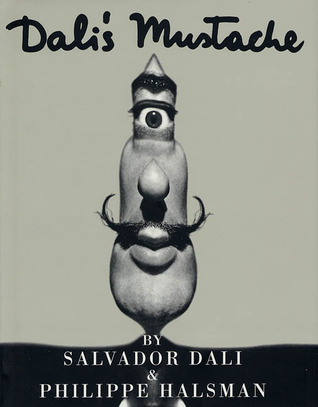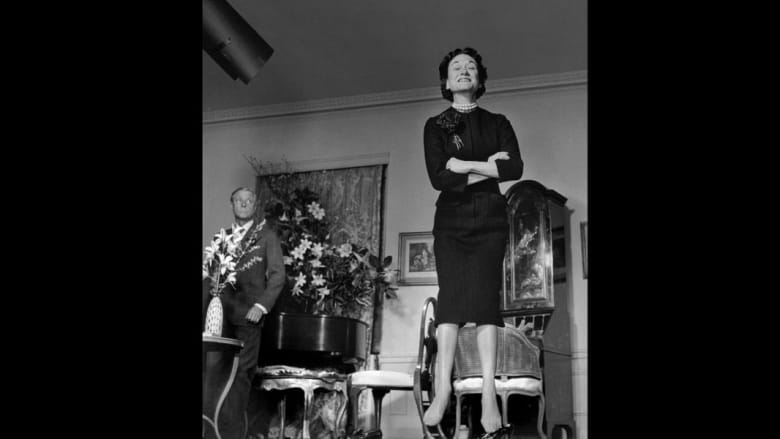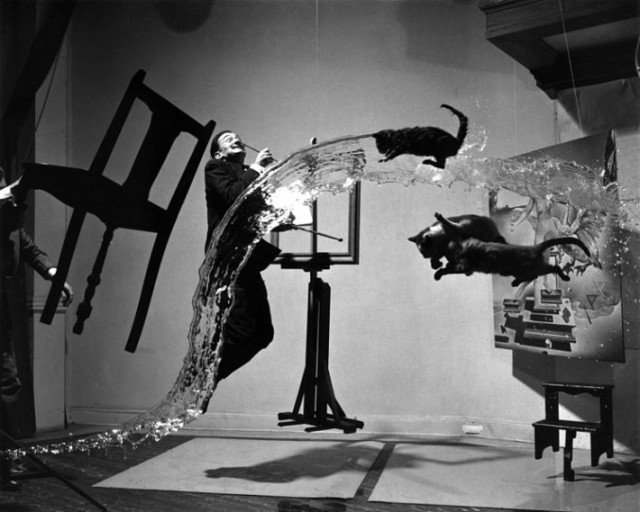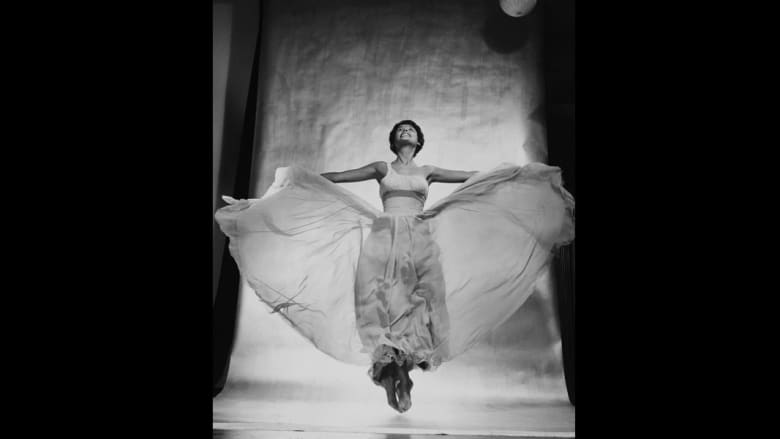
فيليب هالسمان
فيليب هالسمان ( لاتفيا : فيليبس هالسمان ، ألماني : فيليب هالسمان ؛ 2 مايو 1906 – 25 يونيو 1979) كان مصورًا أمريكيًا للصور الشخصية . ولد في ريغا في جزء من الإمبراطورية الروسية التي أصبحت فيما بعد لاتفيا ، وتوفي في مدينة نيويورك .
الحياة والعمل
في سبتمبر 1928 ، تم اتهام هالسمان البالغ من العمر 22 عامًا بقتل والده بينما كانوا في رحلة المشي لمسافات طويلة في تيرول النمساوية ، وهي منطقة مليئة بالمعاداة السامية. [1] بعد محاكمة تستند إلى أدلة ظرفية حُكم عليه بالسجن أربع سنوات. عملت عائلته وأصدقائه ومحاميه من أجل إطلاق سراحه ، وحصلوا على دعم من المثقفين الأوروبيين المهمين بما في ذلك سيجموند فرويد ، ألبرت أينشتاين ، توماس مان ، جاكوب واسرمان ، إريك فروم ، بول بينليفي ، هاينريش إدوارد جاكوب ورودولف أولدن ، الذين أيدوا براءته. قضى هالسمان عامين في السجن ، وأصيب بالسل هناك ، ونشرت رسائله من السجن ككتاب في عام 1930: Briefe aus der Haft an eine Freundin . [1] تم العفو عنه من قبل رئيس النمسا ، فيلهلم ميكلاس ، وأفرج عنه في أكتوبر 1930. [2]
وبالتالي غادر هالسمان النمسا إلى فرنسا. بدأ المساهمة في مجلات الموضة مثل Vogue وسرعان ما اكتسب سمعة كواحد من أفضل المصورين الفوتوغرافيين في فرنسا ، المشهور بالصور الحادة بدلاً من التركيز البؤري كما كان كثيرًا ما يستخدم ، ويتم اقتصاصه عن قرب. عندما غزت ألمانيا ألمانيا ، هرب هالسمان إلى مرسيليا . تمكن في النهاية من الحصول على تأشيرة دخول إلى الولايات المتحدة ، بمساعدة صديق العائلة ألبرت أينشتاين [3] (الذي صوره لاحقًا في عام 1947).
حقق هالسمان نجاحه الأول في أمريكا عندما استخدمت شركة مستحضرات التجميل إليزابيث أردن صورته لنموذج كونستانس فورد ضد العلم الأمريكي في حملة إعلانية لأحمر الشفاه ” فيكتوري ريد “. بعد عام ، في عام 1942 ، وجد عملاً مع مجلة Life لتصوير تصاميم القبعات. كانت صورة نموذج في قبعة ليلي داتشي هي الأولى من أغطية 101 له من أجل الحياة . [4]
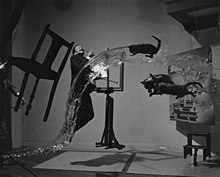
في عام 1941 التقى هالسمان بالفنان السريالي سلفادور دالي . بدأوا في التعاون في أواخر الأربعينيات. يستكشف عمل عام 1948 Dalí Atomicus فكرة التعليق ، حيث يصور ثلاث قطط تطير ، ودلو من المياه الملقاة ، ودالي في الهواء. عنوان الصورة هو إشارة إلى عمل دالي Leda Atomica الذي يمكن رؤيته في يمين الصورة خلف القطتين. أفاد هالسمان أن الأمر استغرق 28 محاولة قبل تحقيق نتيجة مرضية. أصدر هالسمان ودالي في نهاية المطاف خلاصة لتعاونهما في كتاب 1954 دالي شارب ، الذي يضم 36 وجهات نظر مختلفة لشارب الفنان المميز. تعاون آخر مشهور بين الاثنين كان في Voluptas Mors ، صورة سريالية لدالي بجانب جمجمة كبيرة ، في الواقع لوحة تابلوه مؤلفة من سبعة عراة. استغرق هالسمان ثلاث ساعات لترتيب النماذج وفقًا لرسم رسمه دالي. [5] ظهرت العديد من عمليات إعادة التمثيل والإشارة إلى In Voluptas Mors على مر السنين ؛ الأكثر شهرة ، تم استخدام نسخة بمهارة في ملصق الفيلم صمت الحملان ، [6] بينما ظهر إعادة تمثيل علني على ملصق ترويجي لـ The Descent . [7]
في عام 1947 ، صنع هالسمان ما كان سيصبح أحد أشهر صوره لألبرت أينشتاين الحزين ، الذي روى خلال جلسة التصوير ندمه على دوره في الولايات المتحدة في متابعة القنبلة الذرية. ستُستخدم الصورة لاحقًا في عام 1966 على طابع بريد أمريكي ، وفي عام 1999 ، على غلاف مجلة تايم ، عندما وصفت أينشتاين “شخص القرن”.
في عام 1951 ، تم تكليف هالسمان من قبل NBC بتصوير العديد من الكوميديين المشهورين في ذلك الوقت بما في ذلك ميلتون بيرل وسيد قيصر وجروتشو ماركس وبوب هوب . أثناء تصوير الكوميديين وهم يقومون بأعمالهم ، قام بالتقاط العديد من الكوميديين في الجو ، والذي ذهب لإلهام العديد من صور القفز في وقت لاحق من المشاهير بما في ذلك عائلة فورد ، دوق ودوقة وندسور ، مارلين مونرو ، ماريا فيليكس وريتشارد نيكسون .
وعلق هالسمان قائلاً: “عندما تطلب من شخص القفز ، يتم توجيه انتباهه في الغالب نحو فعل القفز ويسقط القناع بحيث يظهر الشخص الحقيقي.” [8] طور المصور فلسفة التصوير بالقفز ، والتي سماها علم القفز. [9] قام بنشر كتاب الانتقال الخاص بـ فيليب هالسمان في عام 1959 ، والذي تضمن نقاشًا في الخد عن علم القفز و 178 صورة فوتوغرافية لقفزات المشاهير.
ناقش كتابه عام 1961 هالسمان حول إنشاء أفكار فوتوغرافية طرق المصورين لإنتاج أعمال غير عادية باتباع ستة قواعد:
- حكم النهج المباشر
- حكم تقنية غير عادية
- قاعدة الميزة غير المعتادة المضافة
- قاعدة الميزة المفقودة
- قاعدة الميزات المركبة
- حكم الطريقة الحرفية أو الأيديوغرافية
يشرح هالسمان في قاعدته الأولى أن كونه واضحًا وصريحًا يخلق صورة قوية.
لجعل موضوع عادي وغير مثير للاهتمام مثير للاهتمام وغير اعتيادي ، تسرد قاعدته الثانية مجموعة متنوعة من تقنيات التصوير الفوتوغرافي ، بما في ذلك الإضاءة غير العادية ، والزاوية غير العادية ، والتكوين غير العادي ، وما إلى ذلك.
قاعدة الميزة غير العادية المضافة هي جهد من قبل المصور لجذب انتباه الجمهور من خلال لفت نظرهم إلى شيء غير متوقع من خلال إدخال ميزة أو دعامة غير عادية في الصورة. على سبيل المثال ، تحتوي صورة صبي صغير يحمل قنبلة يدوية من قبل ديان أربوس على ما يمكن أن يطلق عليه هالسمان ميزة إضافية غير عادية.
القاعدة الرابعة لهالسمان “السمة المفقودة” تحفز المشاهد من خلال مخالفة توقعاته.
القاعدة الخامسة تجند المصور لدمج القواعد الأخرى لإضافة الأصالة إلى صورته.
وأخيرًا ، فإن أسلوب هالسمان الحرفي أو الإيديولوجي هو توضيح رسالة في صورة فوتوغرافية من خلال تصوير الموضوع بأكبر قدر ممكن من الوضوح.
ومن المشاهير الآخرين الذين صورهم هالسمان ألفريد هيتشكوك ومارتن ولويس وجودي جارلاند ونستون تشرشل ومارلين مونرو ودوروثي داندريدج وبابلو بيكاسو وجان كوكتو . [10] ظهرت العديد من هذه الصور على غلاف الحياة . في مثل هذه الصور ، يستخدم مجموعة متنوعة من قواعد التصوير الخاصة به. على سبيل المثال ، في إحدى صور ونستون تشرشل ، يجعل إغفال وجهه صورة هالسمان أكثر قوة في جعل تشرشل أكثر إنسانية.
في عام 1952 ، جلس جون ف.كينيدي مرتين لالتقاط صور فوتوغرافية لهالسمان. ظهرت صورة من الجلسة الأولى على غلاف النسخة الأصلية من كتاب كينيدي لمحات في الشجاعة ؛ تم استخدام واحد من الجلسة الثانية في حملته الانتخابية في مجلس الشيوخ.
في عام 1958 ، تم إدراج هالسمان في مجلة Popular Photography العشرة الأولى في العالم ، وفي عام 1975 حصل على جائزة الحياة في التصوير الفوتوغرافي من الجمعية الأمريكية للمصورين من المجلات ، والتي انتُخب فيها أول رئيس لها في عام 1945. المعارض الكبيرة في جميع أنحاء العالم.
في فيلم 2007 Jump! تم تصوير هالسمان من قبل بن سيلفرستون .
Philippe Halsman
Philippe Halsman (Latvian: Filips Halsmans, German: Philipp Halsmann; 2 May 1906 – 25 June 1979) was an American portrait photographer. He was born in Riga in the part of the Russian Empire which later became Latvia, and died in New York City.
Life and work
Halsman was born in Riga to a Jewish couple, Morduch (Maks) Halsman, a dentist, and Ita Grintuch, a grammar school principal. He studied electrical engineering in Dresden.
In September 1928, 22-year-old Halsman was accused of his father’s murder while they were on a hiking trip in the Austrian Tyrol, an area rife with antisemitism.[1] After a trial based on circumstantial evidence he was sentenced to four years of prison. His family, friends and barristers worked for his release, getting support from important European intellectuals including Sigmund Freud, Albert Einstein, Thomas Mann, Jakob Wassermann, Erich Fromm, Paul Painlevé, Heinrich Eduard Jacob and Rudolf Olden, who endorsed his innocence. Halsman spent two years in prison, contracted tuberculosis there, and his letters from prison were published as a book in 1930: Briefe aus der Haft an eine Freundin.[1] He was pardoned by the President of Austria, Wilhelm Miklas, and released in October 1930.[2]
Halsman consequently left Austria for France. He began contributing to fashion magazines such as Vogue and soon gained a reputation as one of the best portrait photographers in France, renowned for images that were sharp rather than in soft focus as was often used, and closely cropped. When France was invaded by Germany, Halsman fled to Marseille. He eventually managed to obtain a U.S. visa, aided by family friend Albert Einstein[3] (whom he later famously photographed in 1947).
Halsman had his first success in America when the cosmetics firm Elizabeth Arden used his image of model Constance Ford against the American flag in an advertising campaign for “Victory Red” lipstick. A year later, in 1942, he found work with Life magazine, photographing hat designs; a portrait of a model in a Lilly Daché hat was the first of his 101 covers for Life.[4]
In 1941 Halsman met the surrealist artist Salvador Dalí; they began to collaborate in the late 1940s. The 1948 work Dalí Atomicus explores the idea of suspension, depicting three cats flying, a bucket of thrown water, and Dalí in mid air. The title of the photograph is a reference to Dalí’s work Leda Atomica which can be seen in the right of the photograph behind the two cats. Halsman reported that it took 28 attempts before a satisfactory result was achieved. Halsman and Dalí eventually released a compendium of their collaborations in the 1954 book Dali’s Mustache, which features 36 different views of the artist’s distinctive mustache. Another famous collaboration between the two was In Voluptas Mors, a surrealistic portrait of Dalí beside a large skull, in fact a tableau vivant composed of seven nudes. Halsman took three hours to arrange the models according to a sketch by Dalí.[5] Various reenactments of and allusions to In Voluptas Mors have appeared over the years; most famously, a version was used subtly in the poster for the film The Silence of The Lambs,[6] while an overt reenactment appeared on a promotional poster for The Descent.[7]
In 1947 Halsman made what was to become one of his most famous photos of a mournful Albert Einstein, who during the photography session recounted his regrets about his role in the United States pursuing the atomic bomb. The photo would later be used in 1966 on a U.S. postage stamp and, in 1999, on the cover of Time magazine, when it called Einstein the “Person of the Century.”
In 1951 Halsman was commissioned by NBC to photograph various popular comedians of the time including Milton Berle, Sid Caesar, Groucho Marx, and Bob Hope. While photographing the comedians doing their acts, he captured many of the comedians in mid-air, which went on to inspire many later jump pictures of celebrities including the Ford family, The Duke and Duchess of Windsor, Marilyn Monroe, María Félix and Richard Nixon.
Halsman commented, “When you ask a person to jump, his attention is mostly directed toward the act of jumping and the mask falls so that the real person appears.”[8] The photographer developed a philosophy of jump photography, which he called jumpology.[9] He published Philippe Halsman’s Jump Book in 1959, which contained a tongue-in-cheek discussion of jumpology and 178 photographs of celebrity jumpers.
His 1961 book Halsman on the Creation of Photographic Ideas, discussed ways for photographers to produce unusual pieces of work by following six rules:
- the rule of the direct approach
- the rule of the unusual technique
- the rule of the added unusual feature
- the rule of the missing feature
- the rule of compounded features
- the rule of the literal or ideographic method
In his first rule, Halsman explains that being straightforward and plain creates a strong photograph.
To make an ordinary and uninteresting subject interesting and unusual, his second rule lists a variety of photographic techniques, including unusual lighting, unusual angle, unusual composition, etc.
The rule of the added unusual feature is an effort by the photographer to capture the audiences attention by drawing their eye to something unexpected by introducing an unusual feature or prop into the photograph. For example, the photograph of a little boy holding a hand grenade by Diane Arbus contains what Halsman would call an added unusual feature.
Halsman’s fourth rule of “the missing feature” stimulates the viewer by going against his or her expectations.
The fifth rule enlists the photographer to combine the other rules to add originality to his or her photo.
Finally, Halsman’s literal or ideographic method is to illustrate a message in a photograph by depicting the subject as clearly as possible.
Other celebrities photographed by Halsman include Alfred Hitchcock, Martin and Lewis, Judy Garland, Winston Churchill, Marilyn Monroe, Dorothy Dandridge, Pablo Picasso, and Jean Cocteau.[10] Many of those photographs appeared on the cover of Life. In such photos, he utilizes a variety of his rules of photography. For example, in one of his photos of Winston Churchill, the omission of his face makes Halsman’s photo even more powerful at making Churchill more human.
In 1952 John F. Kennedy sat twice for photographs by Halsman. A photograph from the first sitting appeared on the jacket of the original edition of Kennedy’s book Profiles in Courage; one from the second sitting was used in his senatorial campaign.
In 1958 Halsman was listed in Popular Photography magazine’s “World’s Ten Greatest Photographers”, and in 1975 he received the Life Achievement in Photography Award from the American Society of Magazine Photographers, of which he was elected the first president in 1945. He also held many large exhibitions worldwide.
In the 2007 film Jump!, Halsman was portrayed by Ben Silverstone.
Bibliography
- Pollack, Martin. Anklage Vatermord – der Fall Philipp Halsmann, 2002, Zsolnay. ISBN 3-552-05206-2
- philippehalsman.com Web site, “Books by Philippe Halsman”[11]
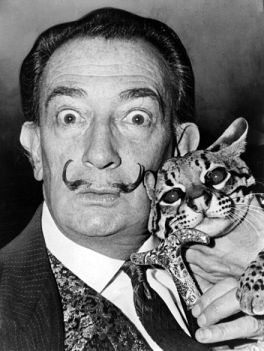
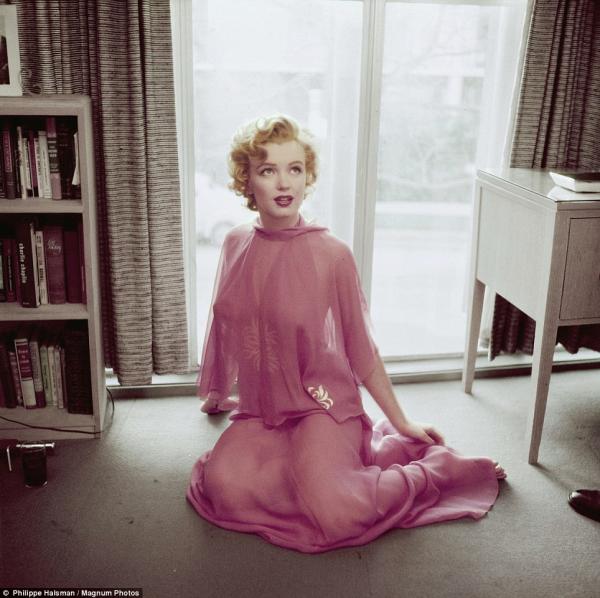
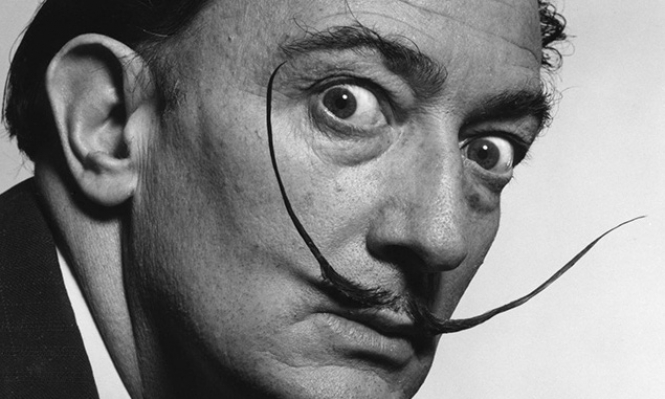

المصور فيليب هالسمان Philippe Halsman
”، والذي تعاون مع سلڤادور دالي ليخرجا بمجموعة صور مبهرة، صاحب رصيد ١٠١ صورة غلاف لمجلة “لايف”



